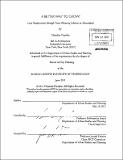| dc.contributor.advisor | Bishwapriya Sanyal. | en_US |
| dc.contributor.author | Deuskar, Chandan | en_US |
| dc.contributor.other | Massachusetts Institute of Technology. Dept. of Urban Studies and Planning. | en_US |
| dc.coverage.spatial | a-ii--- | en_US |
| dc.date.accessioned | 2011-11-01T19:57:28Z | |
| dc.date.available | 2011-11-01T19:57:28Z | |
| dc.date.copyright | 2011 | en_US |
| dc.date.issued | 2011 | en_US |
| dc.identifier.uri | http://hdl.handle.net/1721.1/66885 | |
| dc.description | Thesis (M.C.P.)--Massachusetts Institute of Technology, Dept. of Urban Studies and Planning, 2011. | en_US |
| dc.description | Cataloged from PDF version of thesis. | en_US |
| dc.description | Includes bibliographical references (p. 103-108). | en_US |
| dc.description.abstract | The Town Planning Scheme mechanism for the expansion of the city of Ahmedabad, India, has attracted widespread interest in recent years. It is seen as a participatory and equitable means of acquiring land from rural landowners on the urban fringe. A form of land readjustment, it allows local authorities to acquire a proportion of all the land parcels in a defined area on which to build public roads, parks, and other amenities. The authorities return remaining land to the original landowners in the form of reconstituted parcels, which have increased in value due to the improvements. The landowner pays half of this increase in land value to the government as a betterment charge, which helps the government covers its costs. As it appears to benefit both landowners and the government while also expanding urban infrastructure, proponents often claim that the TP scheme mechanism is a 'win-win' proposition. This thesis evaluates the extent to which the mechanism lives up to the claims made on its behalf. It compares the idealized version of the process laid out in legislation to how it actually works on the ground in Ahmedabad. While landowners and the government both do benefit financially, land valuation is carried out in a roundabout way, with large differences between calculated land values and actual market values. The mechanism is not as participatory as it is often described as being, with the state government playing a controlling role, and courts usually defending the government's use of its wide-ranging powers of discretion. Authorities also have not taken full advantage of the ability of TP schemes to house the poor. This thesis suggests alternative institutional models with which TP schemes could be made more efficient, and which would allow landowners to have greater control over the process. | en_US |
| dc.description.statementofresponsibility | by Chandan Deuskar. | en_US |
| dc.format.extent | 108 p. | en_US |
| dc.language.iso | eng | en_US |
| dc.publisher | Massachusetts Institute of Technology | en_US |
| dc.rights | M.I.T. theses are protected by
copyright. They may be viewed from this source for any purpose, but
reproduction or distribution in any format is prohibited without written
permission. See provided URL for inquiries about permission. | en_US |
| dc.rights.uri | http://dspace.mit.edu/handle/1721.1/7582 | en_US |
| dc.subject | Urban Studies and Planning. | en_US |
| dc.title | A better way to grow? : land readjustment through town planning schemes in Ahmedabad | en_US |
| dc.title.alternative | Land readjustment through town planning schemes in Ahmedabad | en_US |
| dc.type | Thesis | en_US |
| dc.description.degree | M.C.P. | en_US |
| dc.contributor.department | Massachusetts Institute of Technology. Department of Urban Studies and Planning | |
| dc.identifier.oclc | 758256692 | en_US |
